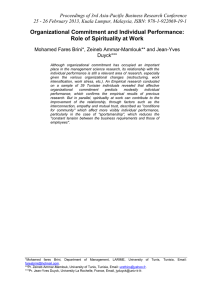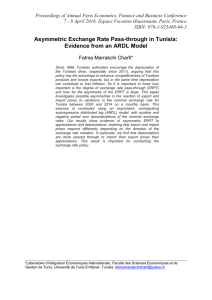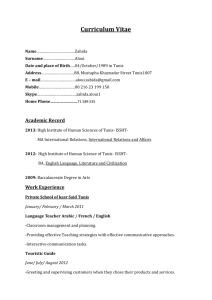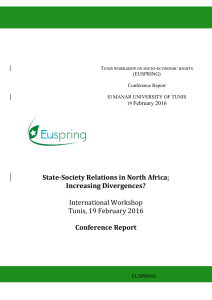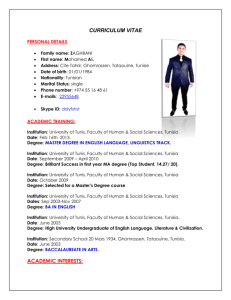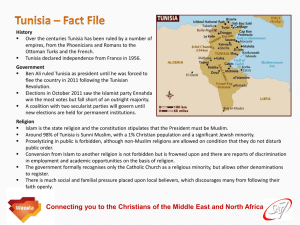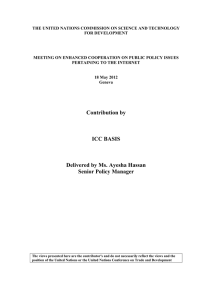English - OIC-VET
advertisement
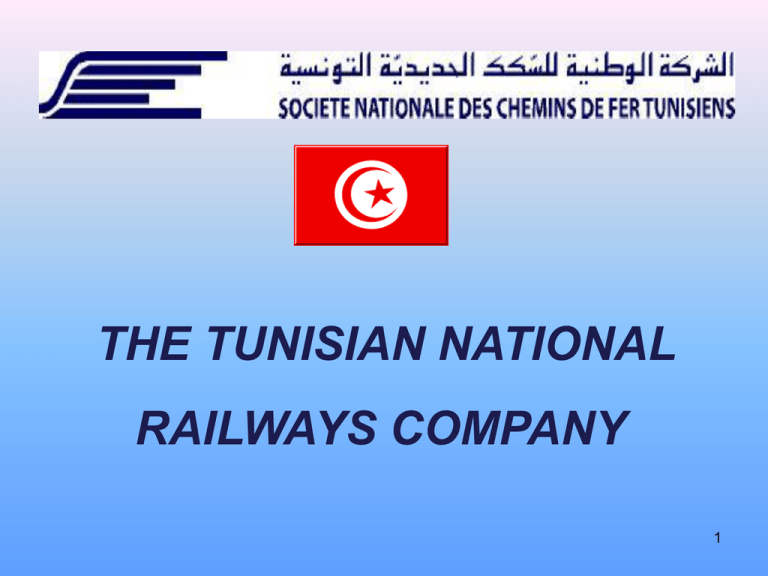
THE TUNISIAN NATIONAL RAILWAYS COMPANY 1 SNCFT is the national railway of Tunisia and is under the direction of the Ministry of Transport. SNCFT was founded on December 27, 1956, headquartered in Tunis capital. Tunisia inherited much of its rail transport system from the French. The Tunisian Government has developed the infrastructure further. 2 History Construction of the northern network (standard gauge) The first railway line in Tunisia linked Tunis with La Marsa - today's TGM line - and was inaugurated on August 2, 1872 by SADOK BEY. Between 1876 and1922, French corporation des Batignolles and its subsidiary, the Bône-Guelma railways compagny built the remain part of the standard gauge network and the link with Algeria. The French company was granted operational rights until 1922, after which it would be sold to the Tunisian state. 3 Construction of the central and southern network (metre-gauge) In 1885, considerable deposits of phosphates were discovered in the region of Seldja. In 1897 a concession was granted to the Phosphate Company and the railways Sfax-Gafsa (CPCFSG) to mine the mineral and to build rail transport to the port of Sfax. The metre-gauge railway between Sfax and Métlaoui via Gafsa was completed by 1899. It was extended in 1913 to Tozeur and 1916 to Gabès In addition, the company was granted a concession to construct The remain part of the southtern network where large holdings of phosphates and iron were found. The southtern network was completed in 1930. At the end of the concession, the lines where to be returned to the Tunisian State. 4 Thus due to historical reasons, the country has two different rail gauge systems: 500 km of standard 1,435 mm (4 ft 8 1⁄2 in) gauge network in the northern part of the country. 1 700 km metre gauge network in the central and southern part. 8 km double gauged track. Tunisia has a rail link with neighbouring Algeria via the border at Ghardimaou. Otherwise two suburbain lines where electrified: Sousse /Mahdia 70 km, 25 kv 50 Hz in1987. Tunis/ Erriadh 25 km, 2x25 kv 50 Hz in 2012. 5 SNCFT provides both passenger and freight services at a national level. SNCFT employs 5400 staff to achieve annual transport : 6 6 million on intercity passenger rail network 7 40 million travelers in the suburbs 8 8 million tons of phosphate 3 million tons of various products BOARD OF DIRECTORS permenante secretairiat the procurement committee audit and control regulatory department President Director General Deputy Director General Management and finance management Central Railways Directorate Planning and Management Control Department Safety and quality department Management Communications and External Relations Informatics department Central Railways Network Operation Department Industrial Maintenance Business Unit Phosphate Business Unit Freight Business Unit Main Lines Business Unit Sahel Suburb Business Unit Tunis Suburb Business Unit SNCFT provides an average daily traffic of 326 trains with a rail fleet consists of: 130 mainline locomotives 41 shunting locomotives 262 passenger cars 25 EMUs 30 DMUs 3846 cars 1266 containers 12 Main future projects 1) RFR projects : Consite to build four new electrified lines for trasport travelers in the suburbs of Tunis Construction works in court for both D and E lines; 13 2) Construction of a new line between Sousse-KairouanHajeb Layoun (130 km) Project is awaiting funding. 14 3) Extension of the electrified railway line Tunis - Borj Cedria to: Soliman (about 7.5 km), feasibility studies have been completed Hammamet- Nabeul (about 53 km) Feasibility study underway. 4) Electrification of the line Tunis - Bizerte (53 km). Feasibility study underway. 15 5) Creation of high-speed lines to connect the main cities of the Maghreb are: Casablanca, Algiers, Tunis and Tripoli. This project is currently under study. The total length of the highspeed lines In Tunisia is: 840 km. 16 THANK YOU FOR YOUR ATTENTION 17
